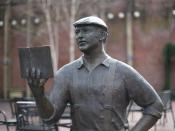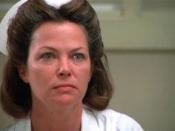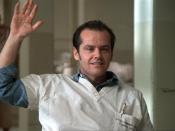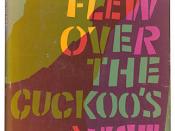Ken Kesey's "One Flew Over the Cuckoo's Nest"ÃÂ The setting of One Flew Over the Cuckoo's Nest is a mental hospital in Oregon, approximately fifteen years after World War I. The characters, with very few exceptions, are inmates and employees of the hospital. By making the narrator one of the patients, the definition between sanity and insanity becomes very unclear. Consequently, we are placed in Chief Bromden's microcosm of life. In here we find the Big Nurse, Nurse Ratched, as the dictator of the ward and the patients as her helpless followers. This represents a society in which the internal policies reflect the way the external world rules. In the beginning of the novel, we find Chief Bromden, a paranoid-schizophrenic Indian, pretending to be deaf and mute. He lives under the dictatorship of Nurse Ratched, who represents the "combine", the intimidating force for conformity that society has created.
When Randle Patrick McMurphy, a convict who is admitted into the ward to avoid prison time, tries to take control of the hospital, the dictator power that reigns over the patients becomes revealed. As a free spirited and fearless individual, McMurphy can perceive the problem because he stands apart from the conformity stricken world that the mental hospital represents. Accordingly, McMurphy opposes the Big Nurse's directions to make life more comfortable and suitable for him. However, with time he realises that the patients are there because they have chosen to be there and that the only way in which he can return to the outside world is through an approval from the nurse to leave.
Once he realises this phenomenon, it is too late to conform because he has now become the strength of all the patients. They have all drawn to him and he has become their only escape into the world they have been deprived of for so long, especially Chief Bromden. At this point, the central conflict, which will now dominate the rest of the novel, emerges with its fullest endowment between the powers of "good" and "evil": McMurphy vs. The Big Nurse. From that point on, both McMurphy and Nurse Ratched engage in a stalwart struggle for control over the minds of the patients. Symbolically, McMurphy is the normal man, representing freedom and individualism. On the other hand, Nurse Ratched is a symbol of mass conformity and a mechanised civilisation.
Each of the main characters contributes to the central conflict. Not only do they originally dislike Nurse Ratched and her devious ways of attaining control, but also because McMurphy represents their freedom. The other workers of the institution side with the nurse, making the "war" even more intense. Incidents such as McMurphy encouraging the inmates into gambling games, smashing his hands through the glass window of the nurses' station pretending to be after a pack of cigarettes, and organising the fishing trip, make McMurphy's influence against Nurse Ratched's dictatorship quite comprehensible.
The fishing trip is one that attributes to a great victory for McMurphy's purpose. It is there, out in the sea, on their own, and out of the hospital, that the inmates learn to act for themselves and regain their self-respect. At this point in the novel is when the "evil" force really begins to feel defeated. Nurse Ratched comes to the realisation that her authority is in danger and begins to take action. Momentarily it appears as though the central conflict's victory will be given to the Big Nurse, when she sends McMurphy and the Chief to get the electroshock treatment. When they return, McMurphy inability to show the inmates that he's the same, is an obvious sign that he is slowly being defeated.
It is now when the reader begins to realise that the lives of the patients are granted only in exchange of McMurphy's death. In his act of desperation to save himself and the others, he takes one more shot at the monster, ripping her outfit and trying to strangle her. At this point, when her breasts are exposed, her power over the inmates is destroyed. McMurphy is therefore taken away for "treatment"ÃÂ and returns like a vegetable after having a lobotomy. Again we see that the nurse wants to leave him there as a symbol of her continuing power, hence making it appear that she has gained the victory. However, the Chief cannot allow this to happen and so asphyxiates McMurphy, when he thinks nobody is watching. Scanlon, who was the only one to have witnessed the crime, helps the Chief escape and promises to testify of having seen McMurphy alive after the Chief had escaped. This is the only way in which the victory over the congruity of society can be preserved. Chief Bromden's freedom is the only way in which McMurphy's sacrifice will be worthwhile. McMurphy's death gives rise to Bromden's "resurrection." The new life, which Chief Bromden will begin, is a symbol of McMurphy's victory. The change of Bromden into a courageous and self-reliant human being, testifies to the power of McMurphy. The central conflict is a continuous battle in which the odds of winning are tossed around from side to side. The central conflict's victory is undoubtedly granted to McMurphy through Bromden, nonetheless, as the novel finishes.
One of the book's most imposing abilities, is the author's choice of narrator. Instead of the normal third-person narrative, Kesey selects a representative from among the inmates themselves. Not just any inmate, but one who also eventually participates with the struggle of the central conflict. Chief Bromden is exceptionally prevailing as a narrator because of the fact that he pretends to be a deaf-mute. This allows him to see and hear many things that are otherwise hidden from other inmates, giving the reader a fuller comprehension of what is in reality going on. Going from a passive observer to an actual participant of the action, also aides in the fullness and completeness of the narration. The transition of character for the narrator shows the clearest indication that McMurphy's therapy in fact is working.
In actuality, Chief Bromden insanity causes some unique problems. Many times, especially in Part One, the reader experiences a difficult time distinguishing between the thin line of reality and fantasy. Nonetheless, these fantasies are symbolic of his perception of the world as he sees it. Being insane, the narrator is free from all preconceived ideas and misconceptions, therefore making the narration realistic. The fog machine is his only way of hiding from what he fears. When reality becomes too intense for Bromden to deal with, he becomes engulfed in this fog where "security" is more attainable. This may appear to take away from the character's ability to narrate, but despite all believes, this makes him an even more consistent narrator. The reports of the fog-situations are told so accurately that this highly qualifies his reliability as a narrator, despite his fragmented vision. Through Bromden's reports is coming from his personal fog, parts are especially revealing, because "your eyes were working so hard to see in the fog that when something did come in sight every detail was ten times as clear. . ." "ÃÂ (p. 103). The other patients lack the "real-depth" of a human, while Bromden does not. This too makes him a more desirable narrator.
The main themes presented in One Flew Over the Cuckoo's Nest are complex and somewhat political in its nature. The machines dominate Chief Bromden's fantasies. These machines are a symbol of the mechanical order, which the "combine," represented by the Big Nurse, is trying to impose upon society, represented by the inmates. Bromden's paranoia is clearly directed to this conformity. This is evident from the beginning of the novel, when Bromden sees Nurse Ratched as a huge machine that is going to eat up the black boys. The references of machinery as conformity are clear. For example, the Shock Shop machines are examples of "The Nurse's" determination to possess control of the "ward." In a way it feels as though the machines are everywhere, on the walls, on the patients, just to keep everything running according to the Combine's plan.
Another theme is that of religious imagery. Kesey uses imagery related with Christ and his crucifixion all throughout the book. However, at the end these images increase. The greatest comparison to the Bible is McMurphy's sacrifice of "giving his life so that others may live". McMurphy's representation of Jesus is, in a way, the escape that society needs to restrain itself from the conformity of the world. This theme also emphasises the fact that every individual has the power within his or herself to overcome the fear that may prevail in his or her heart. One last and final theme present in this novel is the role of women. According this story, women are the downfall of all human kind. Trying to control the men, women represent the political forces that restrain humans from achieving what they desire. And if they don't take on this role, they are to become whores without the slightest control of anything. Or even worse, a follower of the political forces without anything to say in both camps, e.g. the nurse with the big birthmark, which is repelling to the men and under the control of the Big Nurse.
On the other hand you could see the female descriptions as a symbol of the "fundamental"ÃÂ male terror of women who have power. The Big Nurse is such a woman, and the men are terrified of her, because she has the ability to get them "where it hurts the worst"ÃÂ "ÃÂ (p. 51). And when the prostitutes come to the ward, of course to serve men, they're considered to be "good women"ÃÂ because they are neither threatening nor powerful. In other words, you could see the novel as bases upon the "ancient"ÃÂ battle of the sexes.
In my opinion, the novel is an excellent one. The use of an insane narrator made the story line much more challenging. The simple fact of not knowing whether things were really occurring or just a fragment of the narrator's mind made it all that much more appealing. I personally enjoyed the close and personal description the reader got about the paranoia that exist within the ward, enabling me to understand the characters more and see more clearly their reasons for acting certain ways. I also learned to admire Bromden's strength to break what he had been doing for the past fifteen years and McMurphy's sacrifice for those who need him. I feel that not only Bromden grows and comes in closer contact with reality, but the reader also is changed. Through the reading of One Flew Over the Cuckoo's Nest, I learned to see the characters in another way. And it was amazing to see how much us "normal" have in common with the sick"æ





